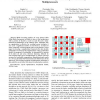Free Online Productivity Tools
i2Speak
i2Symbol
i2OCR
iTex2Img
iWeb2Print
iWeb2Shot
i2Type
iPdf2Split
iPdf2Merge
i2Bopomofo
i2Arabic
i2Style
i2Image
i2PDF
iLatex2Rtf
Sci2ools
IEEEPACT
2009
IEEE
2009
IEEE
Data Layout Transformation for Enhancing Data Locality on NUCA Chip Multiprocessors
—With increasing numbers of cores, future CMPs (Chip Multi-Processors) are likely to have a tiled architecture with a portion of shared L2 cache on each tile and a bankinterleaved distribution of the address space. Although such an organization is effective for avoiding access hot-spots, it can cause a significant number of non-local L2 accesses for many commonly occurring regular data access patterns. In this paper we develop a compile-time framework for data locality optimization via data layout transformation. Using a polyhedral model, the program’s localizability is determined by analysis of its index set and array reference functions, followed by non-canonical data layout transformation to reduce non-local accesses for localizable computations. Simulation-based results on a 16-core 2D tiled CMP demonstrate the effectiveness of the approach. The developed program transformation technique is also useful in several other data layout transformation contexts. Keywords-Data Layout ...
| Added | 24 May 2010 |
| Updated | 24 May 2010 |
| Type | Conference |
| Year | 2009 |
| Where | IEEEPACT |
| Authors | Qingda Lu, Christophe Alias, Uday Bondhugula, Thomas Henretty, Sriram Krishnamoorthy, J. Ramanujam, Atanas Rountev, P. Sadayappan, Yongjian Chen, Haibo Lin, Tin-fook Ngai |
Comments (0)

